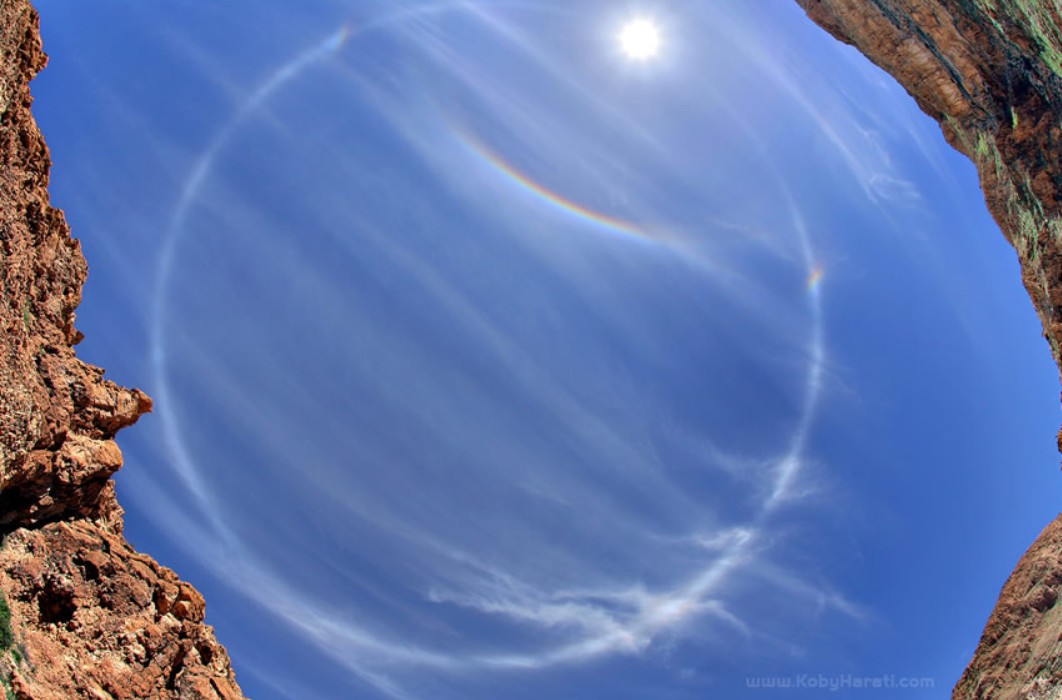Parhelic Circle
Exploring the Parhelic Circle: A Fascinating Atmospheric Phenomenon
Have you ever noticed a captivating white band encircling the sky, seemingly parallel to the horizon and always at the same height as the sun? This intriguing optical phenomenon is known as the parhelic circle. While it may often appear as fragments extending from sundogs, it is worth examining the entire sky as the colorless parhelic circle can sometimes be challenging to distinguish from clouds.
The parhelic circle is formed by millions of ice crystals in the atmosphere, each with vertical faces that reflect and refract sunlight. These crystals act as tiny mirrors, creating an illusion of a circular band around the sky. This mesmerizing phenomenon occurs at the same altitude as the sun, resulting in a consistent height above the horizon.
The Nature of the Parhelic Circle
The parhelic circle is a unique atmospheric optic phenomenon that occurs when sunlight interacts with ice crystals suspended in the atmosphere. The circle appears white due to the absence of any specific coloration, making it blend in with the surrounding sky. However, under certain conditions, fragments of a 22-degree halo, a circumscribed arc, and even sundogs may be visible within the parhelic circle.
Understanding Sundogs and their Role
Sundogs play a significant role in the appearance of the parhelic circle. These bright spots of light are caused by the refraction and reflection of sunlight by ice crystals. Sundogs are typically located on either side of the sun, forming an imaginary line that extends through the parhelic circle. When the sun is positioned higher in the sky, sundogs may not form, so it is essential to observe this phenomenon when the conditions are right.
Identifying the Parhelic Circle
Due to its subtlety, identifying the parhelic circle can be a challenge. However, with careful observation, one can distinguish it from surrounding clouds. Here are some tips to help you identify the parhelic circle:
- Look for a circular band encircling the sky at the same altitude as the sun.
- Pay attention to long tails extending from sundogs, as they may be fragments of the parhelic circle.
- Take note of any colorless bands that appear parallel to the horizon.
Conditions Favoring the Parhelic Circle
To witness the parhelic circle in its full glory, specific atmospheric conditions must align. The presence of ice crystals in the atmosphere is crucial, as they act as the primary source of reflection and refraction. Additionally, the angle of the sun plays a vital role. When the sun is lower in the sky, the parhelic circle is more likely to be visible. However, if the sun is too high, sundogs may form, but the parhelic circle may not be as prominent.
Captivating Images of the Parhelic Circle
Photographers and sky enthusiasts have managed to capture stunning images of the parhelic circle, showcasing its ethereal beauty. These photographs often reveal intricate details within the circle, such as fragments of a 22-degree halo and sundogs. The images serve as a testament to the awe-inspiring wonders of our atmosphere and provide valuable insights into this fascinating phenomenon.
Conclusion
The parhelic circle is a captivating atmospheric optical phenomenon that offers a glimpse into the intricate interactions between sunlight and ice crystals in our atmosphere. Its subtle presence and elusive nature make it a challenge to identify, but with careful observation and knowledge of its characteristics, one can appreciate its beauty. So, keep an eye on the sky, and who knows, you might be fortunate enough to witness the mesmerizing parhelic circle in all its glory!

Parhelic Circle over the Dead Sea imaged by Koby Harati ( Photography site) on March 7, 2007. The camera is pointing straight upwards. The white parhelic circle passes through the sun and circles around sky, everywhere at the same altitude. The coloured halos at top right are fragments of a 22 degree halo, circumscribed arc and, on the parhelic circle, two sundogs. Had the sun been any higher the sundogs would not have formed. Image ©Koby Harati, shown with permission.
The parhelic circle is a white band circling the sky and always at the same height above the horizon as the sun. Most of the time only fragments are seen, usually extending from sundogs in the directions away from the sun. When you see these long tails it is worth checking carefully all around the sky because the colourless parhelic circle can at first be difficult to distinguish from cloud.
Millions of ice crystals with their vertical faces each mirroring the sun around the sky form the circle.
Note: this article has been automatically converted from the old site and may not appear as intended. You can find the original article here.
Reference Atmospheric Optics
If you use any of the definitions, information, or data presented on Atmospheric Optics, please copy the link or reference below to properly credit us as the reference source. Thank you!
-
<a href="https://atoptics.co.uk/blog/parhelic-circle/">Parhelic Circle</a>
-
"Parhelic Circle". Atmospheric Optics. Accessed on July 27, 2024. https://atoptics.co.uk/blog/parhelic-circle/.
-
"Parhelic Circle". Atmospheric Optics, https://atoptics.co.uk/blog/parhelic-circle/. Accessed 27 July, 2024
-
Parhelic Circle. Atmospheric Optics. Retrieved from https://atoptics.co.uk/blog/parhelic-circle/.